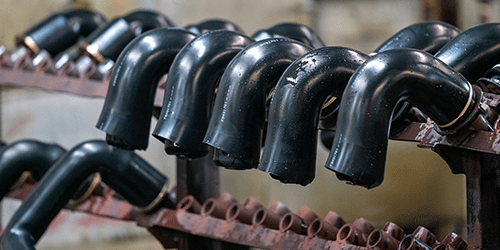Let’s begin with the spoiler: The answer to the question completely depends on the application and environment in which the rubber will be used. Sometimes natural rubber is the best choice and sometimes synthetic rubber is the best option.
The real question is which type of rubber you should choose for your specific project. In this blog post, we’ll compare natural rubber and synthetic rubber so you can make the best choice for your next project.
Natural rubber is a product derived from the latex of the rubber tree, Hevea brasiliensis. It is native to warm, tropical climates like those found in Southeast Asian countries like Thailand, India, Vietnam, and Malaysia.
Liquid latex is harvested from the rubber tree after six years of growth. A thin diagonal cut is made on the tree’s trunk to collect the latex, which is then processed to remove excess water and strengthen it to make it firm. Harvesting latex does no harm to the rubber tree, which is productive for around 30 years, and an average tree can produce 19 pounds of rubber each year.
Researchers are exploring other sources for natural latex, like dandelions and guayule desert shrubs, but most natural rubber comes from the Hevea tree.
The most common use of natural rubber is for car and truck tires.
Synthetic rubber is an artificial elastomer, created by the polymerization of petroleum byproducts. By linking polymer molecules together, synthetic rubber can be made with many different properties and capabilities.
The search to create synthetic rubber dates to the late 1880s but World War II forced urgent research into developing it. Synthetic rubber production in 1941 was 231 tons; in 1945 it totaled 70,000 tons a month. (American Chemical Society) Today, about 70% of rubber used in manufacturing is synthetic, and is a descendant of the synthetic rubber created during World War II.
As mentioned, natural rubber and synthetic rubber have different uses, but the main uses for natural rubber include:
Synthetic rubber can be formulated to make it useful for many different applications and can be found in:
Natural rubber and synthetic rubber are both extremely important and are in high (and growing) demand.
Let’s start with the most prominent benefits of natural rubber:
The variety of synthetic rubber is large, but in general, synthetic rubber has these advantages:
Which lasts longer? Natural rubber or synthetic rubber? Again, the answer depends on how and where it is used because each type of rubber reacts differently to environmental factors and deteriorates at different rates. For example, natural rubber deteriorates faster when exposed to UV rays compared to synthetic rubber, but synthetic rubber is more prone to tearing than natural rubber.
How do natural rubber and synthetic rubber compare, cost-wise? Is one more expensive than the other? This is an apples to oranges comparison because natural rubber and synthetic rubber are not a direct substitute or replacement for one another, and each has very different uses and applications. Plus, both are impacted by supply and demand factors that are independent of each other.
The price of natural and synthetic rubber is in constant flux. For natural rubber, the largest cost-driving factors are related to weather in rubber tree growing areas, rubber tree yield, cost of land, seedlings, and labor. For synthetic rubber, petroleum costs and labor costs drive the pricing of raw materials. and of course, demand plays a key role as well.
The answer to the cost question is always changing based on supply and demand.
Natural rubber is considered to be more eco-friendly than synthetic rubber. Natural rubber is derived from trees, and since it can take 6-8 years for a rubber tree to start producing latex, it encourages tree owners to keep them alive and healthy for longer. Natural rubber also biodegrades at the end of its life.
Synthetic rubber is produced from petroleum, a non-renewable resource, and is not biodegradable.
Each type of rubber has different properties and is suitable for different applications. In general, synthetic rubber better handles temperature extremes and resistance to abrasion. Natural rubber tends to be stronger and more flexible. But in the end, which type of rubber is better depends on your application.
The choice of rubber for your project is a critical decision best left to your engineering team and your rubber manufacturing partner, and experience matters!
The Sperry & Rice rubber engineers utilize our in-house mixing and testing labs to ensure your rubber component is exactly right – performing for its intended use and environment as specified. We can create your custom rubber components from all the rubber types mentioned in this article and do everything it takes to ensure your project gets from concept to completion – on time and on budget.
Have a project that requires natural or synthetic rubber? Contact us!
